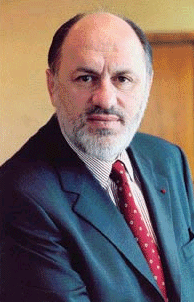Despite the effect of a series of global crises which have hit revenues, French aero engine maker Snecma has managed to reduce gearing and open up new markets. Gaël Cusenier talks to the chairman and CEO.

Q: How is Snecma weathering the continuing crisis?
A: Our results in 2002 were strongly affected by 11 September and our revenues were down 6% year-on-year. For 2003, we expected a return to stability. However, the extremely bad global situation, caused by the war in Iraq and the spread of the SARS epidemic in Asia, has dashed our hopes. In 2003 we will see again a drop in our revenues, though I am confident we'll return a profit for our shareholders. Provided there is not another catastrophe, 2004 should see our return to normality and growth should return in 2005.
Q: What is the current cash position of Snecma?
A: We have a net financial position of €500-600 million, so I am not worried. Especially as I am proud to say that in the current climate we have even managed to reduce our gearing in the last few months: we now stand at 40% which does not represent too high a charge.
Q: How do the different civil business units perform in such a context?
A: No business unit is actually growing; they're at best stable. Our mix is still heavily geared toward the commercial market which generates 80% of our revenue, against 20% for the military. Given the situation in the commercial air transport sector, delivering 400 CFM56 engines in the first quarter is a pretty good result, so we are not too worried about this side of business. We know there is plenty of room for capacity growth in air transport once business picks up, probably in 2005-2006.
Our helicopter activities remain pretty much unscathed by the current turmoil since they do not follow the same cycle. Space activities have been so far the most troubled - we are in a period of crisis. Since the dot-com bubble burst, space launchers have lost most of their customers - telecom operators. However, the 27 May meeting of EU ministers reaffirmed that space remains an ambition for Europe and confirmed budget for Ariane 5.
Q: What do the selection of EPI and the order for the A400M represent for the military activities of Snecma?
A: We are very pleased with EADS' decision to choose EPI engines for the A400M. Very few military engine procurements are launched, so when you're not successful, you have to wait for another 25 years to compete for the following programme. Although, in the last run, we had to lower our price in order to match P&W's offer, as it is customary in this sort of negotiation, the programme will be financially beneficial: it is the duty of any manager to bring value to their shareholders. Furthermore, in the process of delivering the TP400-D6, we'll acquire new technologies that can be leveraged in our other activities.
Q: How are your service activities performing?
A: Snecma has been developing its service activities on a large scale in the past five years, during the growth cycle. We opened a network of service centres around the globe in order to be closer to our customers and provide them with the manufacturer know-how. We have won many contracts in the civilian area, fewer in the military where governments often prefer to build their own maintenance capabilities.
The results vindicate this strategy, because service served as a buffer when orders decreased. Airlines may not buy new equipment, but they still need to maintain their aircraft. Provided they still fly them…
Q: As a French company, do you fear a backlash from the USA due to the strained relations between the two countries?
A: Our partners (GE) and customers (Boeing) in the USA have declared the political strife between our two countries would not affect our business relationships. They know the best way to run their companies is to make their decisions based on economic or technical grounds, not on political ones. Similarly, when an airline decides on buying new equipment, they must take into account their existing fleet, so I am confident we'll keep our customers.
Also, if you look at the CFM56, it is a 50:50 joint venture with GE, a US company, which makes a boycott pretty difficult.
Q: How is Snecma doing in the developing countries?
A: In three important developing markets, we've had mixed blessings.
In Russia, to power the Russian Regional Jet (RRJ), Sukhoi and Boeing selected our SM146 engine and we will develop and manufacture it with NPO Saturn.
In India, we have now several programmes with Hindustan Aeronautics (HAL): co-development of Ardiden engines and supply of TM 333 2B2 engines for helicopters. Plus, the HJT36 training aircraft, powered by our Larzac 04H20 jet engine, made its maiden flight recently. In China, we lost to our partner GE to power their regional jet. However, a third of our activities are in equipment, so we'll now make propositions in that area.
Q: You once envisaged buying FiatAvio. Have you other acquisition plans in view of the fragmented European industry?
A: We were indeed interested in buying FiatAvio, but Fiat decided on another buyer. Nevertheless, we don't regard it as a vital necessity to expand through acquisitions: scale can be interesting, and it was important for a group like Snecma to reach a certain size. However, our debt ratio also is an important matter, all the more so in the current situation.
At the moment, we're happy with maintaining our partnerships at the European level, with Rolls-Royce, MTU or ITP, for example. Le Bourget, though, might be the perfect location to start new discussions…
Source: Flight Daily News























